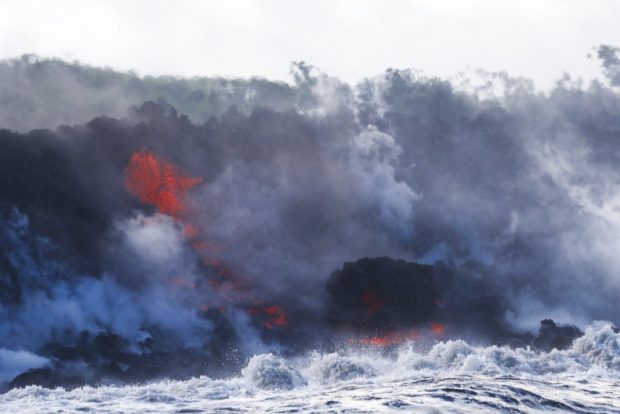
Lava flows into the ocean near Pahoa, Hawaii on Sunday, May 20, 2018. Kilauea volcano that is oozing, spewing and exploding on Hawaii’s Big Island has gotten more hazardous in recent days, with rivers of molten rock pouring into the ocean Sunday and flying lava causing the first major injury. (AP Photo/Jae C. Hong)
PAHOA, Hawaii — Scientists have said sulfur dioxide emissions from Hawaii’s Kilauea volcano have more than doubled since the current eruption began.
The increase, they noted, could boost volcanic smog known as vog but trade winds are currently carrying most of the gas offshore.
United States Geological Survey (USGS) scientist Wendy Stovall said the volcano is belching 15,000 tons of sulfur dioxide each day from ground vents that have formed since May 3.
She said volumes of the gas spiked when the vents began gushing more lava and rivers of molten rock started streaming toward the ocean over the weekend.
Before the Leilani Estates eruption, the volcano’s summit had been releasing an average of 3,000 to 6,000 tons of sulfur dioxide each day.
Another crater had been releasing 200 to 300 tons per day but is no longer emitting sulfur dioxide.
Scientists also said lava from Kilauea volcano in Hawaii is causing fireworks-like explosions as it enters the ocean.
Stovall told reporters Tuesday that lava breaks apart and sends fragments flying into the air when it hits the sea and cools.
She explained explosion can look like fireworks and can also build a small cone, similar to regular volcanic cinder cones.
Stovall said the flying fragments could land on boats on the water.
Scientists have previously said the lava has been creating large steam plumes laced with hydrochloric acid and fine glass shards when it flows into the sea. Plumes of lava haze are also called “laze.”
Kilauea volcano has been erupting in a rural part of the Big Island since May 3. Lava began pouring into the ocean over the weekend.
Earlier, lava flows have claimed another structure, which was close to a geothermal plant.
Hawaii County civil defense officials said lava from an active fissure has destroyed an old warehouse that was used in early research and development at the Puna Geothermal plant.
Hawaii County spokeswoman Janet Snyder told the Honolulu Star-Advertiser that the warehouse adjacent to the plant was destroyed late Monday night.
The building was owned by the state of Hawaii.
To date, nearly 50 structures have been destroyed by lava, including dozens of homes. /kga